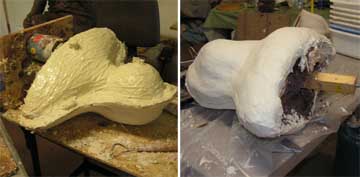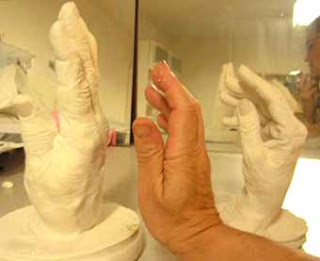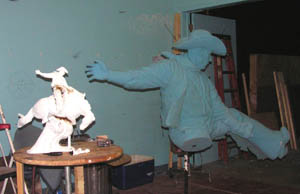Technology in The Art Studio
Created for Best of Artists and Artisans website
By Bridgette Mongeon © 2008

CLAY
In my twenty-three years of sculpting, the process and materials have changed very little. Moving from water-based clay to a wax-based clay was probably my biggest change over the years. It was really done out of necessity. Being a commissioned sculptor, the time between starting a sculpture and a final approval could be months. Trying to keep a water-based clay portrait or a life-size figure from drying out and cracking was a nightmare and when introduced to Classic Clay (brown firm AB200) from Reynolds Advanced Materials, I made the switch. Almost all of my work is created for reproduction by either the manufacturer of my gift items or my foundry for bronze. I rarely fire sculpture in the kiln. In using Classic Clay I no longer have to keep my sculptures wet over the months of time that it takes for an approval, but having to heat up the Classic Clay, with crock pots and torches is a bit inconvenient. The studio is less dusty with the wax-based clay, than it was with water-based clay but I miss having the feel of the water based clay. Even the process of drying out, that caused me such tension, gave me that leather hard stage in the during the drying process that was perfect for adding fine texture to the sculpture.

Casting Outdoor Sculptures
I also keep my eye out for changes in technology as it pertains to casting material, especially outdoor material. Many years ago, when I cast in concrete, I was desperate for additives or different strong but lighter casting material. Whenever someone would tell me they had a product it always fell short of my expectations. Upon further research, it would not withstand the elements. it would chip or it did not come in bright white so that concrete dyes could be added. I have not poured in concrete in a while, so I do not know if anything new is on the market. Though it would be interesting to know if something is now available.

Mold Making Material
Mold making material is another area where technology is vital to my production. If someone could invent a mother mold material with the strength of fiberglass, but not the smell and toxicity, that would be great. (A mother mold is the structure that is put over a rubber mold when making a mold. The mother mold holds the rubber in place, so that when you pour something in it, it is not deformed. Usually the mother mold is plaster that is heavy or fiberglass resin that is toxic and uncomfortable to work with.)I have tried Plasti Paste, a mother mold material purchased from Reynolds Advanced Materials but personally I was not happy with the results. (photograph shows rubber mold with plaster mother mold)
I’m intrigued with the materials used in special effects and frequent the web sites of Reynolds Advanced Materials and Smooth On ( Reynolds Advanced Materials is part of Smooth On ) to see what new items they have.
I have spent some time ordering and utilizing their free dvd’s and pamphlets. The Reynolds site has an entire section on How To. I would love the free time to play with all of the fun things that can be found from these vendors. And now Smooth On has Youtube videos! Like this one on how to create a face mold.

I recently utilized Smooth On’s material for casting hands, and the process that they discuss in the second YouTube video, is similar to what I did. I cast my mom and dad’s hand and they are now two of my most prized possessions. I wrote about them in my newsletter, and posted my thoughts and the process on my forum. The process was the same as the Smooth On video, though I cast their hands in plaster and the Smooth On video shows plastic. ( picture shows father’s cast, my hand, and mother’s cast)
Digital Enlarging
My most recent endeavor into new technology in the art studio has been digital scanning and enlarging. I visited Synappsys Digital Services and was intrigued by what I saw.
Before I go any further, I must first explain the process that a sculptor goes through to enlarge a sculpture. Often a client will want to see a small maquette, which the artist creates for approval by the client. Then the artist proceeds to enlarge the sculpture by creating a metal armature of pipe or rebar, foam and chicken wire. This armature gives the sculpture structure and support, and the foam offers mass that is light in weight. A final layer of clay is put over the foam and details are added. This process can take weeks. (If you would like to see the entire process of creating a life-size sculpture in this manner, please review my online journal of creating the life-size newsboy.) If a sculpture is going from maquette to monumental, the process is a monumental task!
Synappsys Digital Services, along with a few others in the country offer the resource of digital enlarging. They take your small maquette and digitally scan it. Once the scan is in the computer, the data is compiled to create a 3D model. The 3D model is enlarged in the computer and milled out in urethane foam. I have written about this process in detail for an article in the up and coming Sculptural Review Magazine on technology.

(Picture of the Ranger by Harold Holden maquette and enlarged urethane foam created by Synappsys Digital Services)
I visited Synappsys Digital Services to review the process and was thrilled with this new technology. I can’t wait to use it myself. Of course it is a bit of investment. The cost ranges from $1,500 to 4,000 for scanning and milling a 6-foot man depending on the detail and the density of foam used. They can even spray clay on the foam before shipping it to your studio. This process will save me so much time and money, I am definitely adding it to my repertoire of new resources. While preparing the article for Sculptural Review Magazine, I called many different vendors that offer this process. Here is a short list for your records. Prices can vary between vendors as well as the detail that can be obtained in the scanning and milling.
They say “necessity is the mother of invention”, and looking over this article I can see why. It is necessary that I create, and I love vendors that can assist in my creative process.
List of 3D resources
Digital Atelier, formerly Johnson Atelier
Cyber FX
Direct Dimensions specialize in scanning.
Satellite Model specializes in milling.
Digital stone project This company mills in stone.
All written work is copyrighted and cannot be used, whole or in part,
without the written consent of the author.
